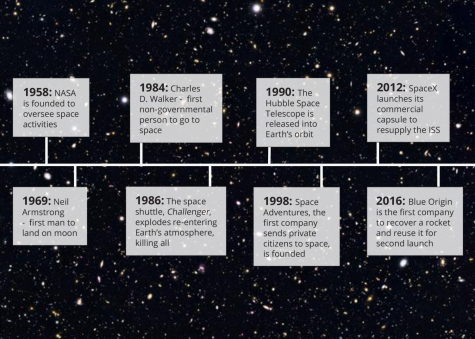Space tourism lifts off, leaving Earth behind
Graphic illustration by Calvin Zhou and Valerie Shu
From landing the first man on the moon to searching for life on other planets, space exploration has always been a symbol of America’s international economic and scientific dominance.
December 12, 2022
From landing the first man on the moon to searching for life on other planets, space exploration has always been a symbol of America’s international economic and scientific dominance. Although space exploration has opened many doors to discovering other habitable bodies and furthering the study of celestial bodies, it has also led to the emergence of commercial space tourism, which is primarily spurred by recreation rather than research. The implications of environmental damage, safety risks and expensive travel render space tourism a defective enterprise, in which people should avoid investing or indulging in.
Space exploration gained traction during the Cold War as the U.S. and the USSR competed against each other to achieve superior spaceflight capability. Starting from the ‘90s to the early 2000s, a wave of private space tourism companies emerged, in which non-governmental personnel, such as researchers, launched missions to land on the International Space Station. Modern space tourism has evolved greatly since then, with companies developing suborbital flights for private citizens, traveling to space at speeds slower than orbital velocity so that they don’t end up drifting in space, and back down to Earth in just a few hours. While this may seem innovative, NASA and other government-funded space programs were able to achieve much more than suborbital flights decades ago, and this focus on small trips distracts from greater innovation.
“Space exploration started with trying to escape Earth’s orbit, and once we achieved that, its focus shifted to creating better ways for sustainability and enabling people to explore unknown territories,” senior Avantika Thiruppukuzhi said.
With reasons for space exploration shifting from scientific to recreational, many private companies, such as SpaceX, Virgin Galactic and Blue Origin have made it their goal to send citizens to the ISS in addition to space exploration. In 2021, “Star Trek” actor William Shatner traveled with Jeff Bezos to space in a Blue Origin rocket. Other celebrities, such as Pete Davidson and Micheal Strahan, have also been on suborbital flights in the past two years. Many celebrities have purchased tickets to expand their work, such as Lady Gaga who intends to be the first person to sing in space and Justin Bieber, who has proposed filming a music video in space. In the pursuit of their goals, these companies have implicitly endorsed only the wealthy and famous to be able to travel to space.
The cost of space travel is very expensive and will most likely not be accessible to all. Across most suborbital space tourism companies, prices range from about $250,000 to $500,000 per seat for a 90-minute ride. SpaceX’s multi-day orbital voyages are estimated to be $50-$55 million. These costs prevent middle-class and low-income people from experiencing outer space as well, providing a clear line on who can explore space and who can’t. The expensive costs of these flights imply that they are essentially a joyride for wealthy individuals, with billionaires disregarding issues on Earth to display their wealth.
“Space tourism is a growing industry and we’ll hopefully see affordable prices in the future, but right now space tourism is only a luxury for billionaires and doesn’t really have an impact on the general public,” Aeronautics Club officer Shrihari Arunachalam said.
Rather than contributing to technological advances or research, the goals of space tourism are geared toward enjoyment and entertainment, which neglect the increasing damage done by the industry. Rocket launches contribute to black carbon emissions, damaging the ozone layer. The first stage of SpaceX’s launch emitted about 116 tons of carbon dioxide in just 165 seconds. Virgin Galactic emits about 90 tons of carbon dioxide, while Blue Origin 93 tons per flight. Current emissions of space tourism account for 6% of total black carbon emissions, which seems insignificant now, but more frequent launches in the near future will become a bigger contributor to global warming — issues that are completely avoidable and unnecessary. Aside from Earth, it also would be near impossible to send millions of people into outer space without polluting Earth’s orbit with space junk.
Although space innovation has come a long way since the 1900s, there are still lots of gray areas and risks when it comes to sending untrained people to space. Spacecrafts that private companies build are not fully safe due to a lack of regulations in the current industry. In 2014, one of Virgin Galactic’s rockets exploded during a test flight due to inadequate safety procedures and training of officials, killing the co-pilot. While The Federal Aviation Administration requires that space companies demonstrate their machines present no risks to people on the ground or the ISS, the FAA does not have any rules regarding the safety of people in flight as they would for commercial airplanes.
Some advantages of space tourism include its contribution to technological advancements. New technology could encourage innovation that could be used for daily life as well. These advances have given some insight into making running shoes, foam mattresses, bulletproof vests, freeze-dried food and much more. Also, space tourism could help spur economic development by encouraging people to invest and creating more jobs in the commercial space tourism industry. However, these minor benefits do not outweigh the potential harm done by the industry.
“The industry of space tourism contributes a lot to environmental damage,” Thiruppukuzhi said. “Also, the funding costs are really high, making it hard to initiate.”
Space exploration has evolved greatly in the past few decades, but the rising industry of commercial space tourism is harmful in the long run due to pollution, costs and safety risks. Spending billions of dollars on expeditions for only those with influence to enjoy themselves is not sensible with other pressing issues that could use the money in more helpful ways, especially compounded by the negative environmental and financial ramifications of the travel. 



































































